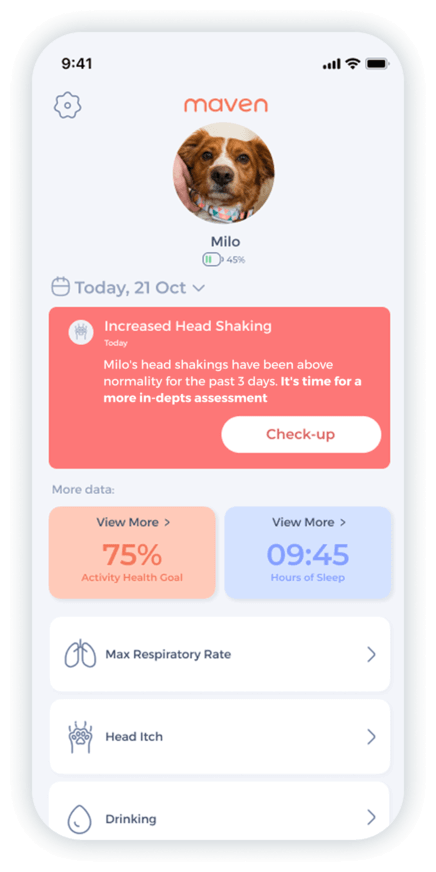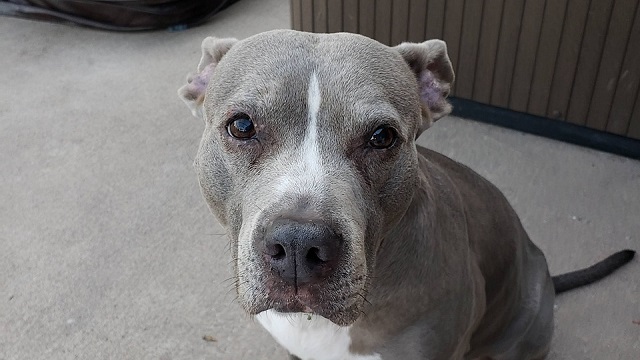Dog Seizures in Older Dogs: 5 Causes and How to Handle Them
Dog seizures in older dogs of 10 years or higher (7 or 8 for bigger breeds) are not uncommon. They can potentially be serious, and many owners of older pups rank them high on their list of concerns.
Naturally, you shouldn’t be alarmed at all times, but you should understand the causes of dog seizures because this will help you act promptly, which is essential in this case. This is largely because older dogs typically have seizures because of structural problems in the brain, like a stroke or a tumor.
As you can expect, these underlying problems can be dangerous, but they may be treatable if you act on time.
One way to do that is to use the Maven Pet smart collar, which can continually monitor your pooch’s health and even detect patterns that might be related to seizures or underlying issues early on.
- Dog seizures are common in older dogs, particularly those over 10 years old.
- Causes include epilepsy, brain tumors, metabolic disorders, low blood sugar, and toxins.
- Recognizing symptoms early helps in responding quickly to seizures.
- Maven Pet smart collar can monitor health and detect seizure patterns.
- Consult a vet after a seizure to identify potential underlying issues.
Common Causes of Seizures in Older Dogs

Five causes are considered to be the most prevalent, so let’s break them down.
Epilepsy
Epilepsy is the most common cause of seizures in older dogs as well as young, albeit it’s primarily diagnosed in young pups. However, older dogs can still develop it and start having seizures as a result, especially by the age of six. Regardless of age, epilepsy is still a condition with unknown underlying causes.
Symptoms:
- Stiff legs
- Blank stares
- Licking of lips
- Uncontrolled movement, typically leg paddling
- Jaw chattering
Brain Tumors or Lesions
Brain tumors and lesions are more common in certain dog breeds as well as in older dogs in general. The breeds that get them more than others are Great Danes, collies, greyhounds, boxers, dachshunds, Boston terriers, and bulldogs.
Common symptoms:
- Behavioral abnormalities, changes in appetite and thirst, and constant circling or pacing with forebrain tumors
- Head tilt, ataxia, circling to the side of the head tilt, flickering of the eyes, and leaning or falling on the side of the head tilt with brainstem tumors
- Head tremors, trunk swaying, wide-based stance, and an uncoordinated gait with cerebellum tumors
“I got the Maven sensor for my 14-year-old Chihuahua mix with heart and trachea issues. It gave me back peace of mind – I can track her RRR, BPM, drinking, and activity anytime and know instantly if something’s wrong. Highly recommend!”

★★★★★
Chiara De Luca
Titti
Metabolic Disorders
Various metabolic disorders can lead to seizures in older dogs, including liver disease and liver shunts, low blood calcium levels, electrolyte imbalance, and kidney disease. There’s no significant influence on the brain, and the seizures caused by these disorders go away once the underlying cause goes away.
Common symptoms:
- Increased thirst
- Increased appetite
- Higher urination

Low Blood Sugar
Low blood sugar, or hypoglycemia, is common in diabetic dogs and those with underlying issues. It occurs when the dog has a low level of glucose circulating through the bloodstream. Hypoglycemia can be very dangerous for dogs, so it needs to be treated quickly.
Common symptoms:
- Lack of energy and lethargy
- Loss of appetite
- Tremors
- Fainting
- Vomiting
- Disorientation
- Coma
Toxins and Medications
Accidental exposure to toxins and medications the dog shouldn’t take can cause seizures, especially in older dogs. If your dog has accidentally swollen something like that or has been poisoned, you should act quickly to solve the issue yourself or with the help of a vet. Symptoms can vary, but you should act even before they are shown.
Common symptoms:
- Vomiting
- Diarrhea
- Dehydration
- Hyperactivity
- High temperature
- Abnormal heart rhythm
- Bleeding from the gut with more serious poisons
- Kidney failure with more serious poisons
What to Do When Your Older Dog Has a Seizure

Now that you’ve seen what causes seizures in old dogs, you should learn what to do if your dog starts having one for the first time. Even though it’s unsettling, don’t get scared, stay calm, and start acting accordingly.
The first step is to determine whether your pup is having a seizure. Some odd behaviors, like twitching, can be confused with seizures.
Before a seizure starts, the pet will likely sense that something is not right, so it’ll likely be anxious and seek attention or try to hide. Once the seizure starts, you’ll see one or more of the following:
- Convulsions
- Paddling
- Teeth chomping
- Unconsciousness
- Urination or defecation
Once the seizure passes, the last stage kicks in, and the pooch will likely be disoriented, confused, and anxious. You might see it pace aimlessly or stumble. The pup might lose sight temporarily or become louder.
So, if your dog is having a seizure, you should do the following:
- Ensure the dog can’t harm itself by placing it on the floor and surrounding it with pillows if it’s on the couch or somewhere from where it can fall.
- Give your pet some space, as this will minimize the time of the seizure. As with people, you’re not supposed to touch the dog if you can avoid it.
- Monitor the dog and the seizure length, but avoid putting your hand too close to its mouth, because your dog might accidentally bite you. During a seizure, the dog is not aware of what’s happening.
- Once the seizure passes, give your pooch some water and comfort them until they get back to normal.
Once everything is back to normal, it is best to visit your vet immediately, especially if this hasn’t happened before. The vet can then determine the underlying cause and start treatment if necessary.
Monitoring Dog Seizures in Older Dogs With Maven Pet
If you’re worried about not catching the early signs, or you simply want to follow your dog’s health, you can do that with a pet smart collar. The Maven Pet Health Monitor can track health indicators like:
- Lethargy or restlessness, both of which can be early signs of a seizure
- Frequency of seizures and their severity by logging symptoms regularly
- Sleep disruptions and other sleep patterns that might occur after a seizure


Monitor heart rate, respiratory rate, activity & rest, drinking, itch behavior.
The primary feature you’ll find useful for pet wellness is the Health Symptoms Journal. Using the app that goes together with the collar, you can document seizure events and your dog’s recovery process in great detail. This will help you follow your pooch’s health, but it might also be helpful info for your vet.
Conclusion

As you can see, dog seizures in older dogs are not uncommon, nor are they something you can ignore or let pass. Understanding what causes them and how to act during a seizure is crucial.
Even though you can’t prevent them, it’s still good to monitor your dog’s health 24/7 with the help of the Maven Pet collar. More than that, it allows you to document seizures so you can stay on top of your pooch’s health. And yes, you can spot other possible issues since the collar has a range of capabilities that will help with other health problems.
If you’re interested, consider subscribing to our service so you can receive your device as soon as possible and start taking proactive action regarding your dog’s health.
Maven Pet focuses on improving the quality of life of our pets with technology, using artificial intelligence (AI) to enable proactive pet care. By accurately collecting and monitoring pet data 24/7 and flagging any irregularities, Maven Pet empowers pet parents and veterinarians to stay ahead of potential health issues, ensuring the well-being and longevity of our beloved companions.





Our 17 year old Lhasa Ahpso started having seizures 3 years ago, Just over 2 months ago we were thinking of having him put down as he was in a poor state.
He has always eaten rice his whole life and we never suspected it but decided to try omitting it not thinking it could be an issue.
Oh my we are now just over 2 months down the line since the day we stopped rice and he has not had a single seizure hes happy tail back up!
Hi Gary, we’re glad to hear your pup has recovered and hasn’t had any more seizures! Best regards to you all 🙂